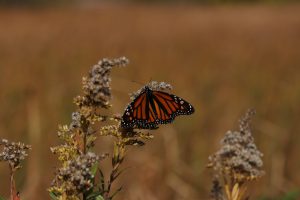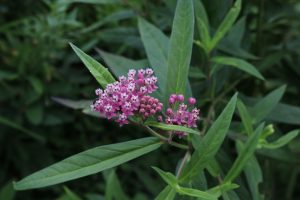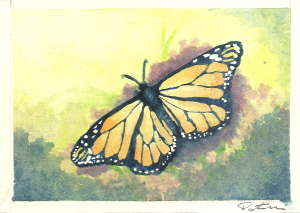by Andres Clavier, Freshwater Stewardship Education Intern
Every year in the fall, millions of monarch butterflies embark on a long-distance journey, migrating thousands of kilometres from North America to California and even central Mexico. This incredible phenomenon is an essential event for our environment as these butterflies are important players in pollination and food chain integration for the geographies they cover. Because of this long journey, these beautiful creatures are facing significant challenges.

A monarch butterfly pauses along its migration to warm up in the sun (Monica Seidel).
The monarch butterfly (Danaus plexippus) has two main populations. The eastern group, starting its journey from as far north as Canada, travels to central Mexico, while its western counterpart heads to the coast of California. These butterflies navigate vast distances by using the sun’s positioning and the Earth’s magnetic pull (Mouritsen & Frost, 2002). This migration from Canada typically starts in late August to September, prompted by decreasing day length and cooler temperatures.
Their epic journey is facing growing difficulties. Climate change, habitat degradation, and pesticides are threatening their migration (Pleasants & Oberhauser, 2013). To measure their populations at their winter sites in central Mexico, scientists measure the number of acres of trees that are occupied by monarch butterflies. For example, in December 2022, a population decrease of 22 percent was measured (Zylsta, et. al, 2021). Their numbers have begun to show a concerning decline; therefore, a call to assist them has never been more urgent.
What can you do?
Plant native wildflowers in your garden
Planting locally beneficial plants is critical for monarch populations. Introducing native plants, especially milkweeds, in your gardens or community spaces can provide critical habitats and nourishment for the monarchs. This not only aids the butterflies but also enriches local ecosystems. Check out our Canada-wide Native Plant Database to learn more about milkweeds and other plant species beneficial to Canadian butterflies and pollinators that you can plant on your property. Many species require cold germination over the winter, so fall is the perfect time to plan ahead for the monarchs that will be returning next spring!

Swamp Milkweed (Asclepias incarnata) is a beautiful wildflower species whose sap is critical for caterpillars of the monarch butterfly to deter predators (Monica Seidel).
Adopt a monarch!
For those inspired to do more, Watersheds Canada offers a unique opportunity! Through our gift catalogue, you can symbolically adopt a monarch butterfly, create pollinator habitat on a property (planting milkweed species), or symbolically adopt a Wild Bergamot, a valuable native wildflower species for monarch butterflies. Your generous contribution will go towards our habitat conservation endeavours, ensuring these magnificent monarchs continue their inspiring migrations for years to come. Each of these purchases come with a postcard featuring Canadian artwork, and are eligible for a Canadian income tax receipt.

The monarch butterfly symbolic adoption package comes with watercolour artwork done by Canadian artists, Payton Muro.
By recognizing the challenges monarch butterflies face and stepping forward with simple, actionable solutions, we can all be part of their conservation. Let’s unite to ensure the Canadian skies remain graced with these stunning emissaries of resilience, wonder, and joy.
References
Mouritsen, H., & Frost, B. J. (2002). Virtual migration in tethered flying monarch butterflies reveals their orientation mechanisms. Proceedings of the National Academy of Sciences, 99(15), 10162-10166.
Pleasants, J. M., & Oberhauser, K. S. (2013). Milkweed loss in agricultural fields because of herbicide use: effect on the monarch butterfly population. Insect Conservation and Diversity, 6(2), 135-144.
Zylsta, ER, Ries, L, Neupane, N., Saunders, SP, Ramirez, MI, Rendon-Salinas, E., Oberhauser, KS, Farr, MT, Zipkin EF. 2021. Changes in climate drive monarch butterfly dynamics. Nature Ecology and Evolution. 5:1441–1452.

i am in love wit;h MONARCHS
They are muc less plenty than when I was a child It saddens me, greatly
I fear that the milkweed on my property is not the BEST kind
Please advise the best kind so that I can prepare for next year
Do butterflies fly close or BY / past the okefenokee swamp it says that there are BIRDS there
Are Monarchs toxic for birds to eat or do the birds try anyway?